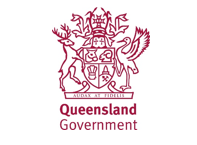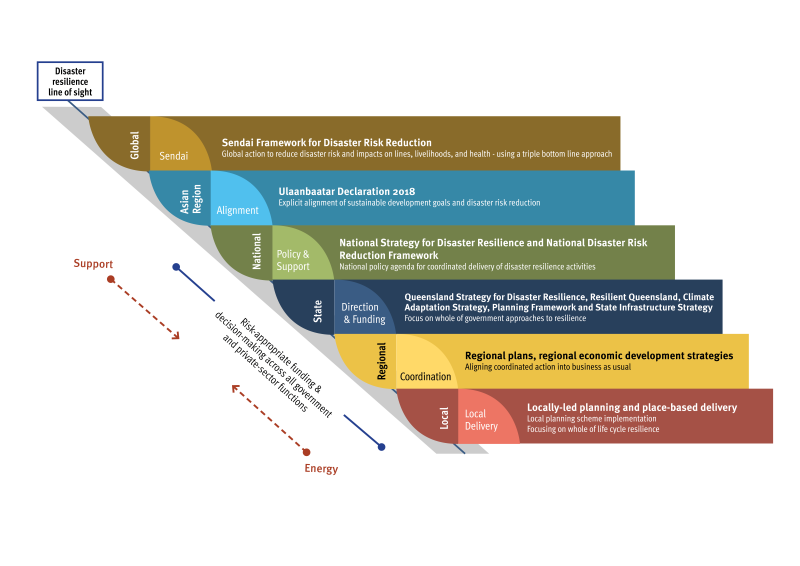Global and national resilience policies
On this page:
Disaster resilience line of sight
Queensland's Strategy for Disaster Resilience aligns with global, national, state, regional and local resilience policies and initiatives as outlined in the diagram below showing the resilience line of sight.
Global
The Sendai Framework for Disaster Risk Reduction 2015-2030 was adopted at the Third United Nations World Conference on Disaster Risk Reduction in Sendai, Japan, in March 2015.
The Sendai Framework is one of three global agreements developed as part of the ‘post 2015 sustainable development agenda’. Together with the Sustainable Development Goals and the Paris Agreement on Climate Change, the Sendai Framework sets the strategic approach for how nations should approach disaster risk to achieve a substantial reduction of disaster risk and losses in lives, livelihoods and health, and in the economic, physical, social, cultural and environmental assets of persons, businesses, communities and countries over the next 15 years.
Unsurprisingly, over the past decade extreme weather events, the pandemic, and failure of climate change mitigation and adaptation have remained as a central feature on the global risk landscape. In May 2022, the Seventh Session of the Global Platform for Disaster Risk Reduction (GP2022) was held to learn from the COVID-19 pandemic, evaluate successes and challenges in working on disaster risk reduction, and to accelerate progress towards disaster resilience and sustainable development. As highlighted during the GP2022, managing complex and interconnected risks, such as climate change, pandemics, ecosystem degradation, nature and biodiversity loss represent some of the most pressing global challenges of today. There is significant opportunity within innovation, emergent capacities and collaboration that can help manage disaster risk.

(External link to https://www.undrr.org/publication/sendai-framework-disaster-risk-reduction-2015-2030)
(External link to https://globalplatform.undrr.org/)
National
The Australian Government leads the nation's policy approach to strengthen national resilience to natural hazard induced disasters. The National Emergency Management Agency (NEMA), and its predecessors the National Recovery and Resilience Agency, the National Resilience Taskforce and Emergency Management Australia, have played a significant role in guiding disaster recovery and resilience activities through the National Strategy for Disaster Resilience, the National Disaster Risk Reduction Framework (NDRRF), and the National Action Plan – which together provide the overarching framework to reduce disaster risk and improve Australia’s resilience . Increasing pro-active and coordinated investments and actions in resilience-building is critical to support the NDRRF and Action Plans. The second National Action Plan is under development and will continue the work towards improving Australia's disaster resilience.

(External link to https://knowledge.aidr.org.au/resources/national-strategy-for-disaster-resilience/)

(External link to https://knowledge.aidr.org.au/resources/national-disaster-risk-reduction-framework/)

(External link to https://knowledge.aidr.org.au/resources/second-national-action-plan-for-disaster-risk-reduction/)
State
The Queensland Strategy for Disaster Resilience (QSDR) aligns with international, national and state disaster risk reduction and sustainable development agendas with the key state strategies and frameworks being the Queensland Disaster Management Arrangements (QDMA), Queensland Emergency Risk Management Framework (QERMF) and the Queensland Climate Adaptation Strategy (Q-CAS).
Queensland’s disaster resilience is built through collaborative approaches that are locally-led, regionally coordinated and supported by state resources. These are guided by local leadership, flexibility and adaptation, shared responsibility and prioritisation, with a view to resilience becoming business as usual. Queensland recently achieved its voluntary commitment to the UNDRR Sendai Framework for Disaster Risk Reduction – delivery of Regional Resilience Strategies in Queensland, which enables communities to be aware of their disaster risks and aims to reduce disaster risk through integrated resilience planning across economic, human and social, built, roads and transport and environmental lines of resilience.

(Internal link to www.qra.qld.gov.au/qsdr)

(Internal link to https://www.qra.qld.gov.au/recovery/recovery-governance/queensland-disaster-recovery-arrangements)

(External link to https://www.disaster.qld.gov.au/queensland-emergency-risk-management-framework)

(External link to https://www.qld.gov.au/environment/climate/climate-change/adapting/strategy)
Regional and local
The Queensland Government is committed to strengthening disaster resilience so our communities are better equipped to deal with the increasing prevalence of natural disasters. As a result of statewide engagement over recent years, by the end of 2022, every region across Queensland will be part of a locally-led and regionally coordinated blueprint to strengthen disaster resilience.
